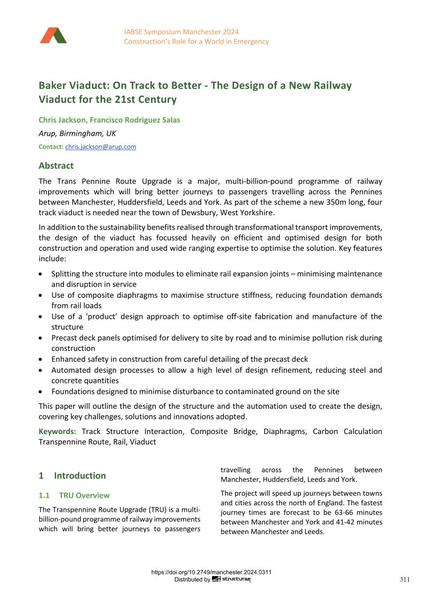Baker Viaduct: On Track to Better - The Design of a New Railway Viaduct for the 21st Century

|
|
|||||||||||
Bibliographic Details
| Author(s): |
Chris Jackson
(Arup, Birmingham, UK)
Francisco Rodriguez Salas (Arup, Birmingham, UK) |
||||
|---|---|---|---|---|---|
| Medium: | conference paper | ||||
| Language(s): | English | ||||
| Conference: | IABSE Symposium: Construction’s Role for a World in Emergency, Manchester, United Kingdom, 10-14 April 2024 | ||||
| Published in: | IABSE Symposium Manchester 2024 | ||||
|
|||||
| Page(s): | 311-318 | ||||
| Total no. of pages: | 8 | ||||
| DOI: | 10.2749/manchester.2024.0311 | ||||
| Abstract: |
The Trans Pennine Route Upgrade is a major, multi-billion-pound programme of railway improvements which will bring better journeys to passengers travelling across the Pennines between Manchester, Huddersfield, Leeds and York. As part of the scheme a new 350m long, four track viaduct is needed near the town of Dewsbury, West Yorkshire. In addition to the sustainability benefits realised through transformational transport improvements, the design of the viaduct has focussed heavily on efficient and optimised design for both construction and operation and used wide ranging expertise to optimise the solution. Key features include: Splitting the structure into modules to eliminate rail expansion joints – minimising maintenance and disruption in service Use of composite diaphragms to maximise structure stiffness, reducing foundation demands from rail loads Use of a ‘product’ design approach to optimise off-site fabrication and manufacture of the structure Precast deck panels optimised for delivery to site by road and to minimise pollution risk during construction Enhanced safety in construction from careful detailing of the precast deck Automated design processes to allow a high level of design refinement, reducing steel and concrete quantities Foundations designed to minimise disturbance to contaminated ground on the site This paper will outline the design of the structure and the automation used to create the design, covering key challenges, solutions and innovations adopted. |
||||
| Keywords: |
viaduct composite bridge rail diaphragms Track Structure Interaction Carbon Calculation Transpennine Route
|
||||
